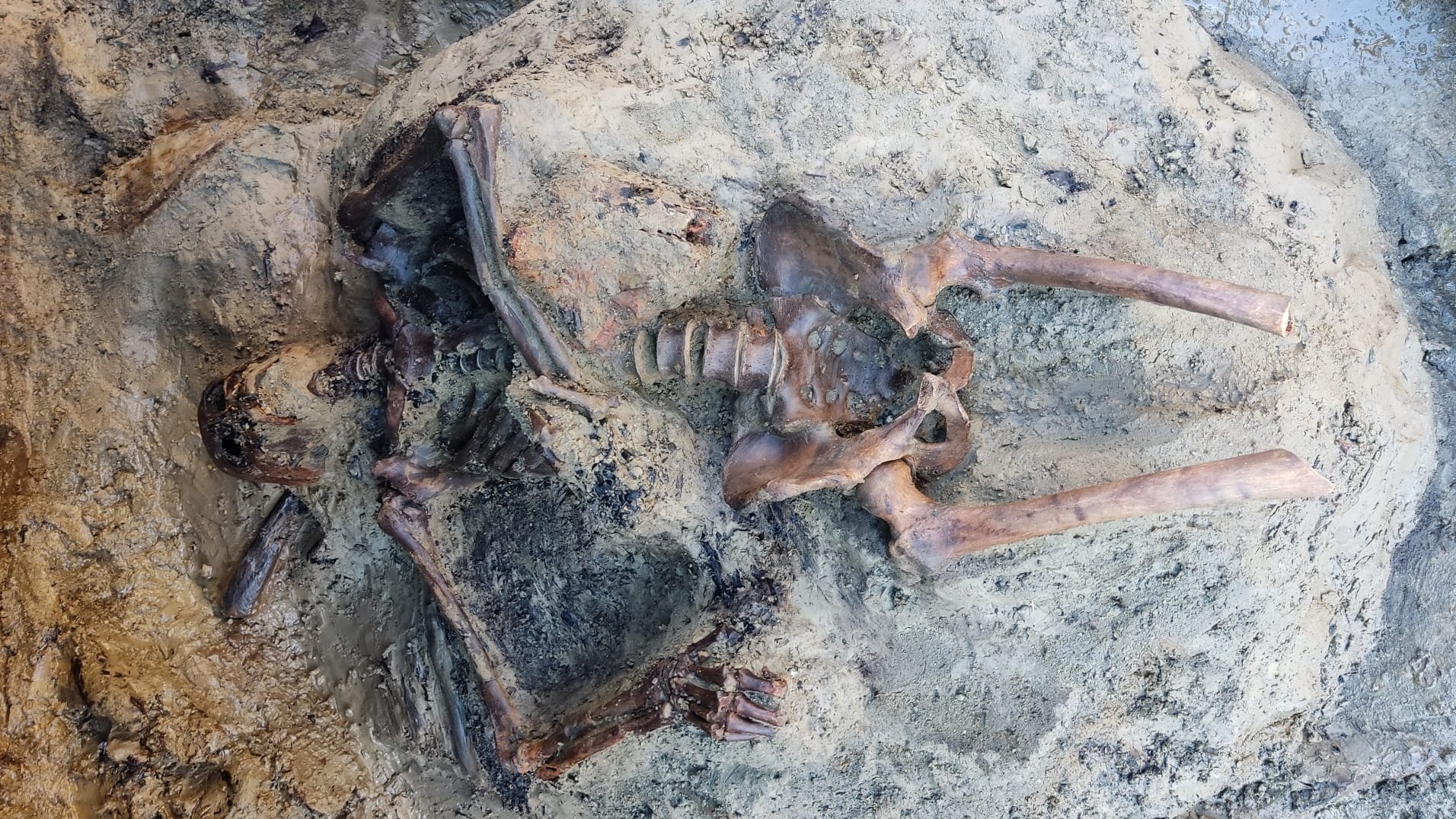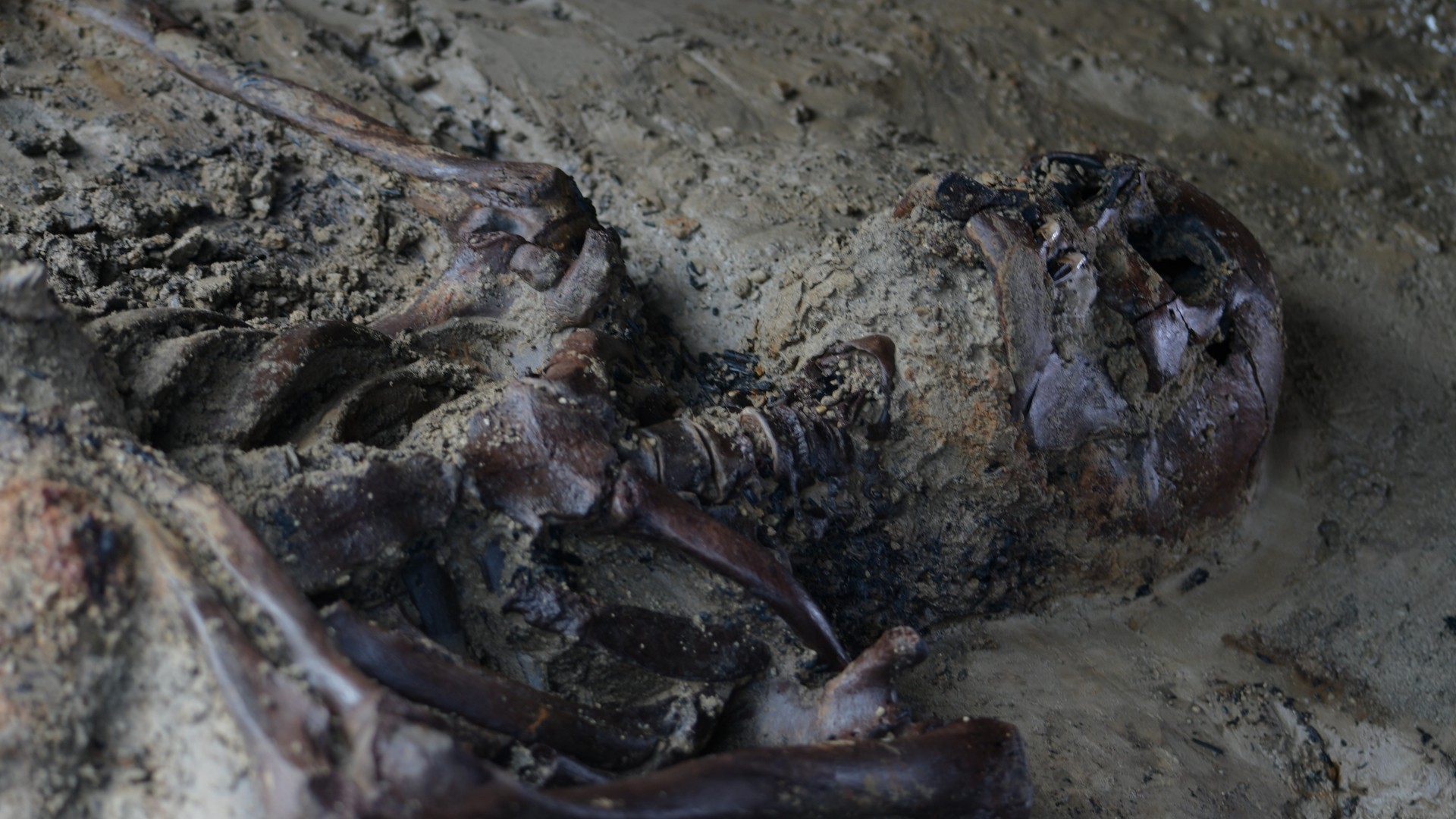Remains of man who was 'vaporized' by Mount Vesuvius 2,000 years ago discovered
The skeleton has been unearthed at Herculaneum.

The skeleton of a man killed by the deadly eruption of Mount Vesuvius almost 2,000 years ago has been unearthed from an ancient beach at Herculaneum — possibly as he ran in an attempt to escape the disaster.
The man was killed just steps from the sea in the ancient Roman town, which like Pompeii was destroyed by the colossal eruption of Vesuvius in A.D. 79.
Archaeologists think the man was running from the "boat sheds" in the town — actually stone arches used to store nets and fishing equipment — when he was overcome by the intensely hot "pyroclastic" cloud from the eruption that engulfed Herculaneum at a speed of more than 60 mph (100 km/h).
"When the pyroclastic cloud arrived, the temperature was above 500 degrees [Celsius, 930 degrees Fahrenheit] — it was very, very hot," Francesco Sirano, the director of the Herculaneum Archaeological Park, told Live Science. "It was so hot that everything living was vaporized immediately, like this man."
All that remains now are the man's bones, which show he was facing away from the sea and toward the land when he fell on his back — presumably because he had turned to face the onrushing cloud of hot gas and volcanic debris, Sirano said. It's thought the pyroclastic cloud then carried the body to the edge of the water along the ancient beach and maybe into the shallows, he said.
Related: Photos: The bones of Mount Vesuvius
Ancient town
Herculaneum, on the Bay of Naples, was one of several Roman towns destroyed by the eruption of Vesuvius. Like the city of Pompeii, about 8 miles (13 kilometers) to the southeast, Herculaneum was covered by a layer of ash from the eruption that preserved it from both the elements and looting until it was rediscovered early in the 18th century.
Sign up for the Live Science daily newsletter now
Get the world’s most fascinating discoveries delivered straight to your inbox.
Most of the dead found at Herculaneum — more than 300 people — were killed in the stone arches about 100 feet (30 meters) inland, where it's thought they had taken shelter to await rescue from the sea when they were overcome by the pyroclastic cloud.
Writing about 25 years later, the Roman author Pliny the Younger stated that his uncle Pliny the Elder — a philosopher who was also the Roman admiral of the region — had ordered naval boats to Herculaneum to rescue people there from the eruption of Mount Vesuvius. The mission wasn't successful, however, and the eruption killed Pliny the Elder at a town called Stabiae, a few miles south of Pompeii, Live Science previously reported.

Earlier this year, archaeologists determined that the skeleton of a different man discovered at Herculaneum in the 1980s may have been a Roman military officer who had been sent there with the rescue fleet by Pliny, Live Science reported.
But the man found recently wasn't wearing a uniform, and doesn't seem to have been a soldier. Analysis of his skeleton suggests he was between 40 and 45 years old, Sirano said, and the remains of a wooden box he seems to have been carrying in a fabric bag have survived — presumably it contained his most prized possessions. Among them is an object made of metal, possibly a ring, although more research is needed to determine what it was. "We can argue that maybe he was a Roman citizen of the town, and not one of the members of the rescue expedition," he said.
Pyroclastic cloud
Although Pompeii suffered two pyroclastic surges, many people in that city survived them only to be killed by falling debris. But the initial pyroclastic cloud at Herculaneum was more intense and killed many people almost immediately. (Archaeologists think about 1000 people survived at Herculaneum, out of a population of about 5,000, while most of the roughly 20,000 people at Pompeii are thought to have survived, Live Science reported.)
The lack of oxygen in the pyroclastic cloud at Herculaneum also meant that organic objects were carbonized rather than burned. As a result, wooden roof beams, doors, and even meals have been found there. The newfound victim was also surrounded by carbonized debris, Sirano said, including shrubs, the roots of trees, roof beams and fragments of frames and panels probably from houses.
Although archaeologists initially explored the area of the ancient beach in the 1980s, they recently returned there, thanks in part to financial support from the Packard Humanities Institute in the United States, he said.
The skeleton is the first found of any victim of Vesuvius in 14 years, and provides archaeologists with an opportunity to apply the latest scientific techniques — including 3D photogrammetry, of every phase of the excavation. That analysis should reveal a snapshot of the tragedy that will hopefully reveal new insights into the eruption and everyday life in the ancient town, Sirano said.
Originally published on Live Science.
Tom Metcalfe is a freelance journalist and regular Live Science contributor who is based in London in the United Kingdom. Tom writes mainly about science, space, archaeology, the Earth and the oceans. He has also written for the BBC, NBC News, National Geographic, Scientific American, Air & Space, and many others.










